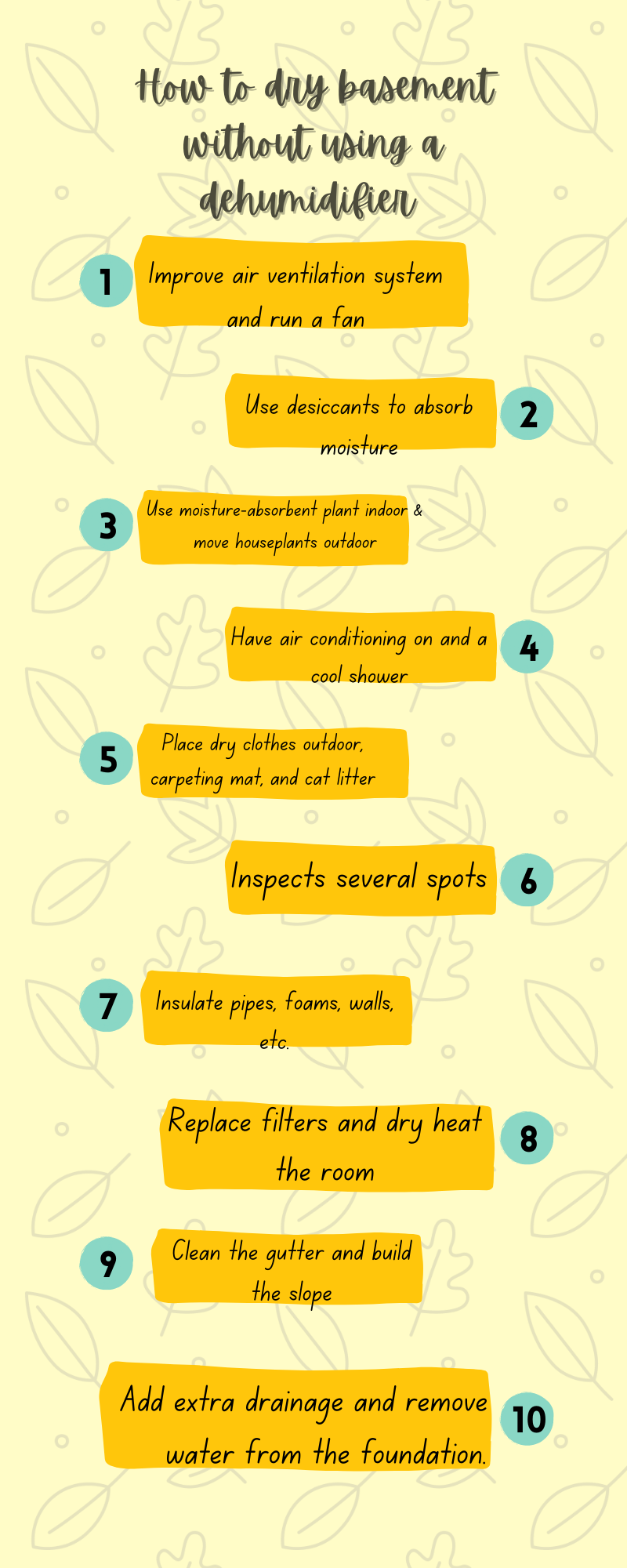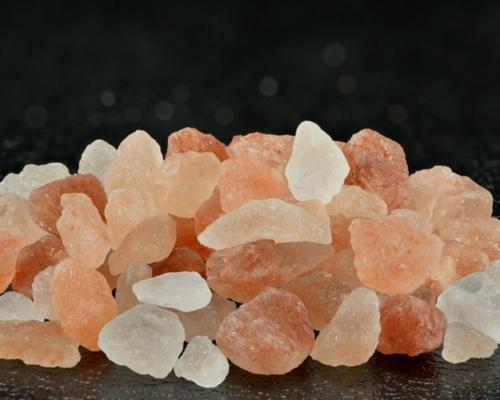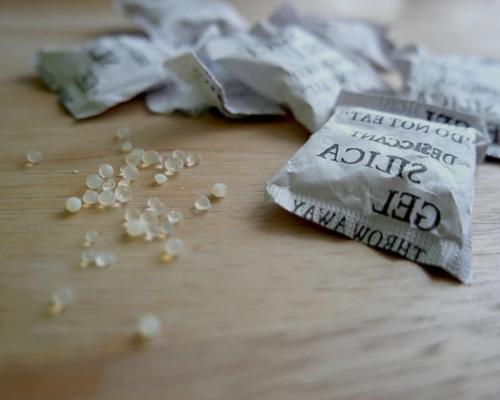Cat litter can reduce the humidity of the basement. Astonishing, right? In this article, I will deep dive into 10 simple steps to dry out a basement fast without a dehumidifier. People love to use dehumidifiers to see the result faster. As you do not want to use it to reduce moisture, I do not want to keep these methods secret. Here is the answer to your question in short.
How to keep basement dry without dehumidifier?
- Improve air ventilation system and run a fan
- Use desiccants to absorb moisture
- Use moisture-absorbent plant indoor & move houseplants outdoor
- Have air conditioning on and a cool shower
- Place dry clothes outdoor, carpeting mat, and cat litter
- Inspects several spots
- Insulate pipes, foams, walls, etc.
- Replace filters and dry heat the room
- Clean the gutter and build the slope
- Add extra drainage and remove water from the foundation.
I will discuss them in detail later in this article. You should also know why your basement gets humid to take a measurable step. On top of that, how to identify a humid basement is necessary. In this article, I will talk about these topics with some frequently asked questions by homeowners. Keep reading.
How to Keep Basement Dry Without Dehumidifier?
Here are the all possible ways to reduce moisture from the basement without using a dehumidifier. I believe these work for you to live a comfortable life in your home.

Improve Airflow, Ventilation System and Run a Fan
Improving airflow from the outside is a no-cost method for drying out your basement. However, you have to be careful when you open up your windows. If the outside humidity is higher than the inside, you should not open the window. When outside lower humid air enters into the inside, this will decrease the inside humidity. The lower the humidity in the room the basement the drier.
Install a vent fan in the wall or ceiling. A vent fan will allow more air to the outside that has high humidity. You can do it by hiring an electrician.
You can also run a ceiling fan that will push air up and outside from the basement. If you are using a table or portable fan, you can place it on the table for better efficiency. Besides, you can use a basement fan. You might be thinking how big the basement fan should be? Do not worry, you have to install a basement fan according to the room’s size. You have to run a fan at a slower speed when there has a humidity island in your basement.
Use Desiccants to Absorb Moisture
We all know there have many desiccants available in the market. I have listed only four out of them based on their effectiveness. You can use these desiccants to absorb moisture from the air and so the basement.
Rock salt
Rock salt, a homemade basement moisture absorber, is also known as crystal salt (calcium chloride). You have to put it in a plastic bottle or pot. It will automatically absorb the moisture from the room air and basement.

All you have to do are – empty the pot or bottle when it is full of water. Again, place rock salt on it. If you think your basement is severely humid, you can place more than one pot in the room.
Charcoal
Charcoal works as other desiccants do. Fresh charcoal briquettes can absorb moisture from the air as a dehumidifier. You have to put it in a tin or box, make some holes at sides and lid. Then place it in the basement where the moisture is high. See the magic!

You have to change the charcoal after a couple of weeks when it is soaked up with water.
Silica gel
It is a little bit dangerous in use however experts recommend it to use as a desiccant. You will see silica gel comes with a bag labeled “DO NOT EAT”, right? Keep them away from children and your pets. Place a silica gel packet in the basement, it will absorb water from the air. Just to let you know, silica gel is made of silicon dioxide. Finally, replace it when the bag is full of water.

Desiccant bags
Desiccant bags and silica gel works in the same manner. Desiccant bags are used in larger scales to reduce humidity from the air like – in transportation thorough ship. You can place a desiccant bag in your room, and see the result. You might find it helpful, I believe. Replace and empty the bag when it is full of water.

Baking soda
Every house has this component for baking purposes. Now, you have to use it for reducing moisture from the air. Keep some baking soda in a jar or bowl, then place the jar in the humid basement. You will see the bowl partially soaked up the next day. When the whole baking soda is soaked up with water, you have to change (3-4 weeks) it immediately.

Dimprid
It is similar to silica gel and desiccant bag. Place a dimprid container in the basement where humidity is higher. The crystals of dimprid will start absorbing water from the air. The water will start stored in the container. You have to empty the container when it is full of water.

One thing you should follow is that dimprid is not suitable to all extents.
Use Moisture-absorbent Plant Indoor & Move Houseplants Outdoor
Some plants absorb moisture whereas, some plants increase it in the air. So, you have to place some moisture-absorbing plants to get rid of humidity pretty naturally. Nevertheless, you should know which houseplants contribute to increase humidity.
Reed palm
It usually grows in humid zones and tropical regions in the world. It absorbs moisture from the air through its leaves. Then the water goes to leaves through the xylem. Finally, excrete out via root.
Peace lily
Peace lily also absorbs moisture from the air using its leaves. It requires a little bit of sunlight for better growth. So, you have to maintain optimum growing conditions in the room.
Bostern fern
This plant works as an automatic dehumidifier. It absorbs water from the air but keeps balancing the moisture level with the outside environment.
Cactus
We know cactus grow in desert areas. It can collect water wherever it finds it e.g. from the air. It stores water in its stem and a waxy protein coat prevents coming out. So, you can place cactus trees indoors to keep your basement dry naturally.
Houseplants that you move outside
Houseplants increase the humidity by their physicochemical activity like – respiration and photosynthesis. The plants that increase the humidity often have a huge amount of leaves with a large surface area. So, you should not keep jade plants, and spider plants inside your house.
Have Air Conditioning on and a Cool Shower
The air conditioner not only cools the room’s air but also can reduce the humidity level. How? It pulls the warm and moist air from the room and passes through the refrigerant coils. The condensation of air produces water and excrete out like water. That means, water vapor in the air comes out and room humidity level decreases at the same time.
So, you can run your air conditioner at optimum speed and temperature to dry out the basement fast. As a cool shower produces less steam than a hot shower, you can take a cool shower to reduce basement humidity.
Place Dry Clothes Outdoor, Carpeting Mat, and Cat Litter
Line drying of clothes indoors worsens your room’s air humidity. It is wise to place dry clothes outdoor and dry them in direct sunlight to reduce humidity. Drying under direct sunlight is a kind of sterilization method.
Use of carpeting mat to line basement can prevent the basement from humidity. As a result, your furniture will get rid of warping up due to dampness. Remember, you should change and dry the carpet mat when it is soaked up with water. Otherwise, mold will start growing on it.
Placing cat litter over the basement can help with basement humidity. Sounds crazy, right? Well, cat litter can absorb water from the basement directly but it can not absorb water from the air. So, you should use it in the basement when you are following another method. Using cat litter for reducing humidity is useful for people having cats.
Inspects Several Spots
You should inspect the walls and windows. Are there any cracks or holes in the walls and windows? If you can not be able to find cracks, you can hire professionals or read blogs on “how to find cracks or holes on the walls”.
Humid air enters the room through these cracks and holes. The more humid air in the room, the more humid condition of the basement is.
The bathroom above the basement can also humidifier the basement because of cracks in the tiles.
In the rainy season, the air is over-saturated with water vapor. So, you should seal all of the cracks before the rain.
Insulate Pipes, Walls, Etc.
After a keen inspection, now it is time to insulate all of the spots. Pipes water can be condensate and humidify the basement. Besides, outside water can condensate through your house walls. You should insulate pipes with inexpensive foam, and insulate the walls with styrofoam.
You can also paint the walls with your favorite color to prevent condensation of outside air.
Replace Filters and Dry Heat the Room
Filters like – AC or furnace filters allow air into the room. If they are clogged with dust, moisture will build up in the room because of slow airflow. So, you should clean them carefully and replace them in need.
Dry heating of the room combined with moisture absorbent is another way to reduce the humidity level in your room. You can dry heat the room with a wood-burning stove or a furnace. Notice here, keep the airflow outside the window. Do not use the gas heater.
Clean the Gutter and Build the Slope
You should clean the gutter to prevent the backflow of water towards the basement. You should inspect the gutter whether it is obstructed with dirt, branches, leaves, or anything else.
You should maintain a 4 ft slope from the house basement to the ground for smooth water flow. Thus, water will not back towards the house.
Add Extra Drainage and Remove Water From the Foundation
Adding extra drainage is vital for people living in heavy rain or snowfall areas. After a flood the water mobed throughout the basement. So, planting a drainage tube is needed indeed. The drainage tube should be connected to a sump pump to remove extra from the drainage.
You can follow any methods mentioned above to keep basement dry without dehumidifier.
Why Does Your Basement Humid?
You may be tired of running a dehumidifier but no positive results. You should know all of the possible ways that make your basement humid. Let’s jump into them –
Sump basin
A sump pump is used to sent excess water outside from the basement. If the sump pump is smaller or larger than it should be, it can cause basement humidity. So, you should choose a sump pump that is suitable for your basin.
On top of that, the sump pump may fail to pump. You should enquire about its functionality. If it can not pump, a small amount of water will remain at the bottom. This water then produces steam and increases the humidity of your basement. So, you can cover up the pump for this issue.
Season
In summer, the air is warm and humid. When this air comes in contact with the room’s cool air, it produces water vapor. As a result, the basement becomes humid. Running an AC is the solution for this situation along with moisture absorbents.
The humid air enters through wall and window cracks or holes, so you should insulate them. Insulating walls can pricier.
Plumber err
There may have cracks in your water pipes, or pipes have the worst slopes. Water comes out through the cracks and causes humidity to the basement. You will find it harder to detect cracks in the pipes, you can hire professionals and insulate them with foam. The cracked bathroom’s tile should be sealed by experts.
Plants in the basement
The basement gets humid by plants in the basement or near the basement window. One or two plants do not occur humidity but a large number of plants can cause it.
Poor ventilation
Due to poor ventilation, humid air does not go outside of the house. The moisture build-up in the basement.
How To Identify Your Basement Is Humid?
If you do not how to identify your basement whether humid or normal, you might break your bank by buying a whole-house dehumidifier. I am not saying, buying a wall-mounted dehumidifier is any bad. But, you should know how to identify your basement is humid. Let’s learn it –
Musty and heavy air
If any house or basement has excessive moisture, the air becomes heavy and musty. You will feel a little difficulty breathing.
Mold
In excess humidity, you will see mold growing in the walls and floor. A warm and moist environment is favorable for mold growth.
Condensation
I have mentioned earlier, when warm air comes in contact with the cool surface, the air becomes condensed. You will see condensation in the basement.
Humidistat
Place a humidistat in the basement or hang it on the floor. After a couple of hours, you will see the reading is higher due to the high water vapor in the air. You can buy it from Amazon, it is cheaper than you think.
Efflorescence
The basement is porous. Efflorescence means crystallized minerals come through the pores when the humidity is higher.
Frequently Asked Questions (FAQs)
How Can I Dry My Basement Fast?
To dry your basement fast, you should maintain proper ventilation, use moisture absorbents, seal the cracks and holes, clean the gutter, use a sump pump, place moisture-absorbing plants, etc. Besides, you can insulate walls for preventing outside air from getting inside.
Where in A Basement Should I Place the Dehumidifier?
You should place the dehumidifier in either downstairs or upstairs basement. You should place the dehumidifier in a place where the humidity level is higher. So, you have to detect this place first and then place a dehumidifier.
How Do I Dry My Room Fast without A Dehumidifier?
To dry your room without a dehumidifier, you should use only a fully functional sump pump. If a sump pump works efficiently, you do not need to run a dehumidifier anymore. You can invest this money in a water level alarming system and cover.
Conclusion
I hope you get your question answered in detail after reading how to keep basement dry without dehumidifier. I think you must detect the cause first and then take an initiative. You may start with a no-cost option. What if free methods do not work, you can go for a sump pump.
